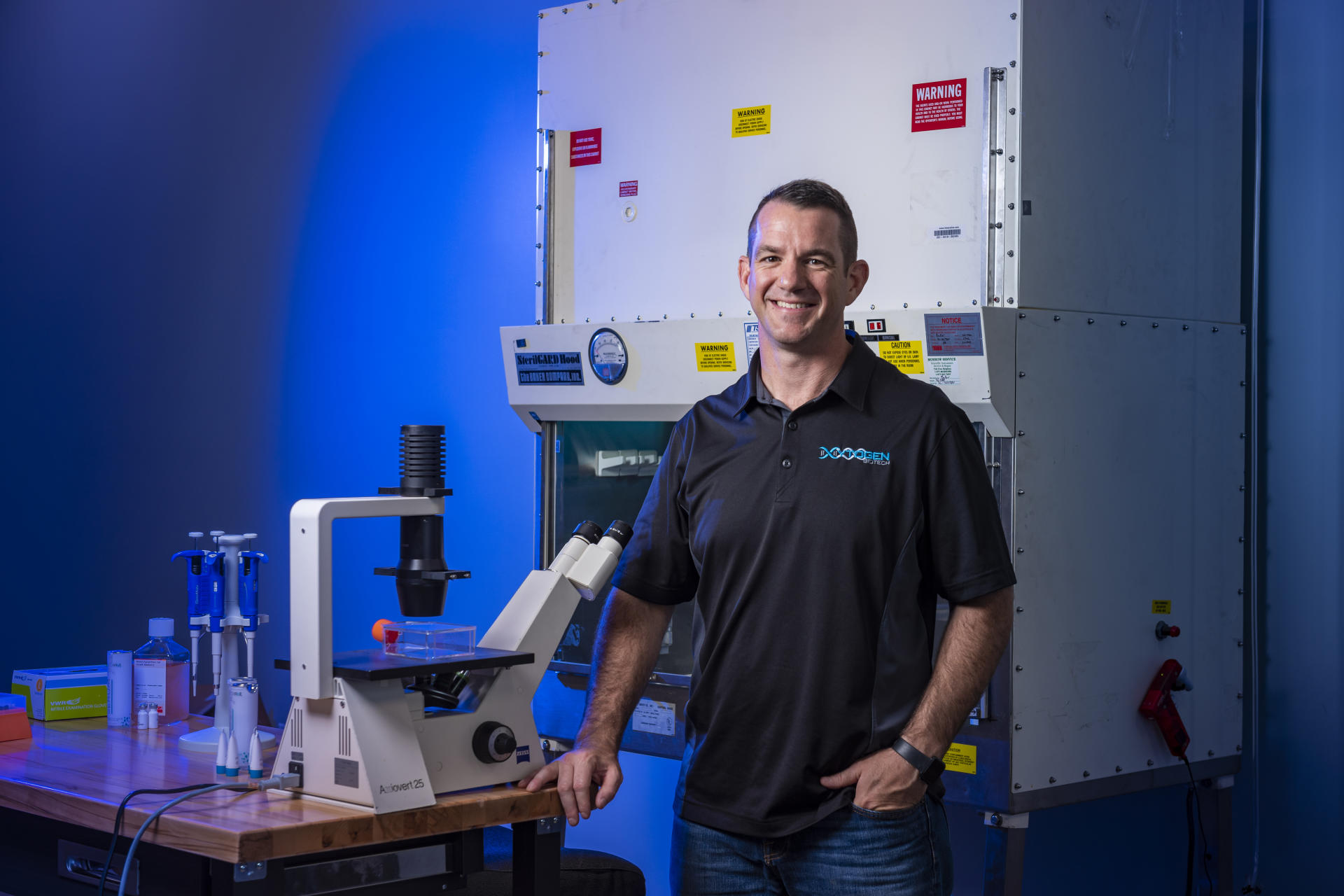5 Questions with Alumnus John Aylworth

Chico State alum John Aylworth founded Xytogen, a biotech company researching and using stem cells for anti-aging products on Friday, August 9, 2019 in Chico, Calif. Aylworth recently moved his business from the south Bay Area back to Chico. (Jason Halley/University Photographer/CSU Chico)
John Aylworth founded Xytogen in March 2015 on the principle of researching the natural therapeutic power of stem cells within the human body. Five years later, the COVID-19 pandemic gripped the globe, and Xytogen is researching using stem cells in an inhalant to battle lung inflammation caused by the coronavirus at its lab and research facility in southeast Chico. With background in the medical industry, Aylworth (Business Administration, ’04; MBA, ’09) seamlessly transitioned from business student to leading a research company—with the goal of conducting that research in Chico and tapping faculty experts and undergraduate and graduate students from his alma mater to carry its work forward.
How does someone with a business degree and MBA become interested in stem cells?
Before I was a business major, I was actually pre-med. I’ve always been fascinated with medicine and medical technologies. I’ve always had an affinity for the sciences, even though I ultimately took my education in a different direction. Coming straight out of my undergraduate education, I landed a really cool job as a consultant to orthopedic surgeons. I was in the operating room a lot, and I really liked that. I started out in trauma surgery and then evolved into joint replacement surgery. My job was essentially as an expert over the equipment the doctor might use to repair somebody’s knee, and not as an expert on the anatomy of the surgery. I collaborated with the physicians and the staff to help make sure things went smoothly. I really loved that job, but I wanted to get my MBA to prepare myself for advancement in that type of profession.
How do you plan to use stem cells to treat lung infections in COVID-19 patients?
One of the biggest reasons COVID is an issue is how inflamed your lungs get. When the pulmonary tissue becomes highly inflamed, it expresses mucous and a pus-type of liquid which fill the lungs—this is pneumonia. The stem cell proteins do a really good job of modulating inflammation and bringing it back to normal levels. The theory with the inhalant is that we can capture these proteins, called interleukins, and you can deploy them through an inhaler. The proteins will spread along the inner walls of your lungs, covering over your lungs from an inhalant dose that your body will recognize, because your lung cells are attuned to receive interleukins. This is a protein your body is used to and comfortable with. It’s not like trying to talk your body into receiving a new drug it’s never seen before. We’re essentially taking the healing essence that exists in all of us and redeploying it to the lungs by way of an inhalant. We have begun some experiments in our Chico laboratories already, and all of our research so far has been very promising.
Where did you get this idea?
It seems like a big leap, but because we’ve been doing this research for so long—extracting these stem cell proteins to see how they work in different products—we’ve known about the interleukin family for years. It’s actually not that big of a leap. I initially pitched the idea to my science team and asked, “what if we put this thing in some type of a solution using a type of metered-dose inhaler, like an asthma inhaler, to get a protein to the lungs?” To their credit, my science team is open-minded and didn’t say, “oh, you’re just a business guy, you’re not allowed to have any ideas.” Instead, they looked at it from a scientific lens: “Can we harness the protein, can we make sure it survives the process, can we make sure it survives suspension in this fluid?” They started asking and answering the scientific-related questions, and it gained momentum of its own.
What do you see as the future of stem cells in therapeutic use?
My honest-to-goodness belief is that in the not-too-distant future, stem cell proteins will be in everything. The body of literature describing what they can do is almost unlimited. Search for any pathology you can possibly think of and 50 articles will pop up by people who have studied it and showed positive results. Stem cells are absolutely going to be in everything. We’re biological entities and our bodies are factories producing therapeutic medicine. Right now, we’re just producing it for our own bodies and our bodies have evolved to resolve the problems that happen when we get sick, wounded, or damaged. It’s only in the last couple hundred years that we’ve introduced outside chemicals to try to assist our body with that process. I’m not dissing outside medicine—pharmacology has its place, of course. But the extent through which we can truly understand and read the essence that exists within our body already, we’ll have a whole new field of medicine that I think is going to be in everything. I think there’s unlimited therapeutic potential.
Which skills from graduate school do you use in your current work?
The skills I learned from my MBA days that I most frequently rely upon are the strategic thinking skills taught by [Management Department professor] Jeff Trailer. I often consider his course and his inspiring lectures when I am stumped on how to proceed with a given strategic initiative. I would also credit [Management Department lecturer] Sean Morgan’s course on entrepreneurship as a source of ongoing inspiration. Sean required me to check my unbounded optimism and draft a feasibility analysis in his course. This was, of course, very wise counsel and has served me again and again since I started my own company.


